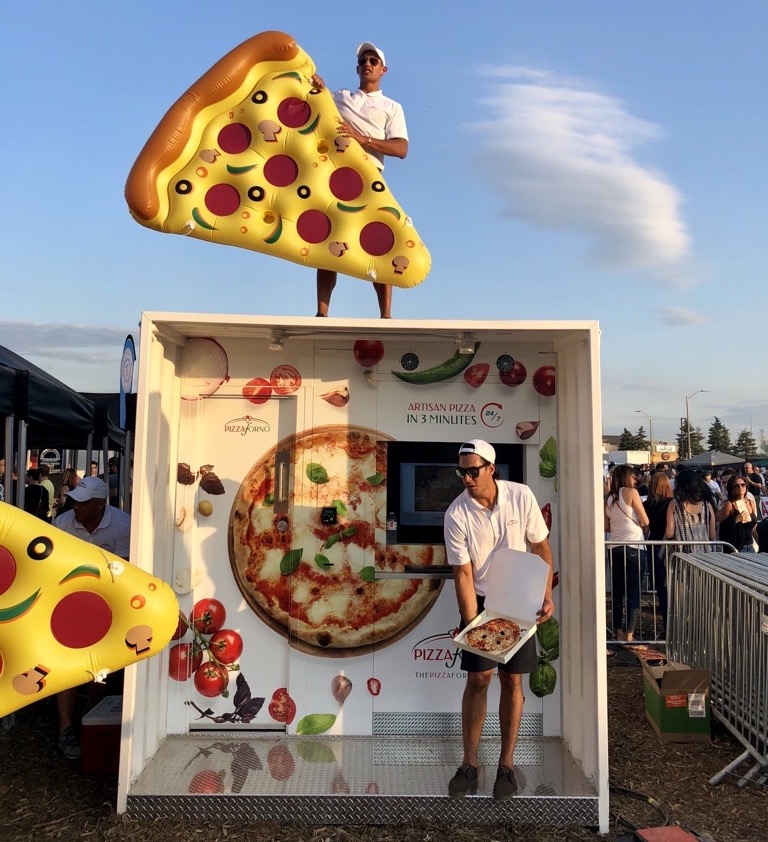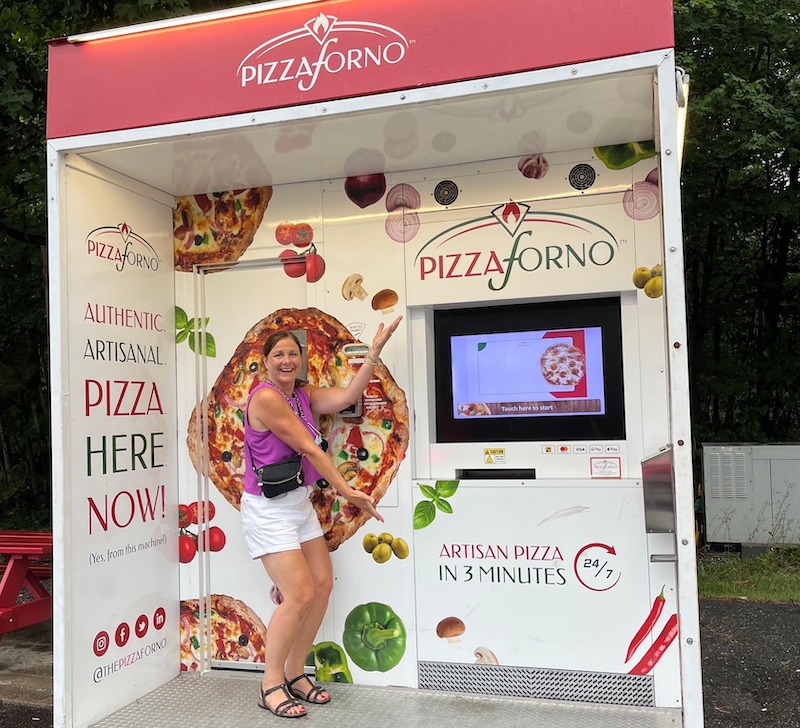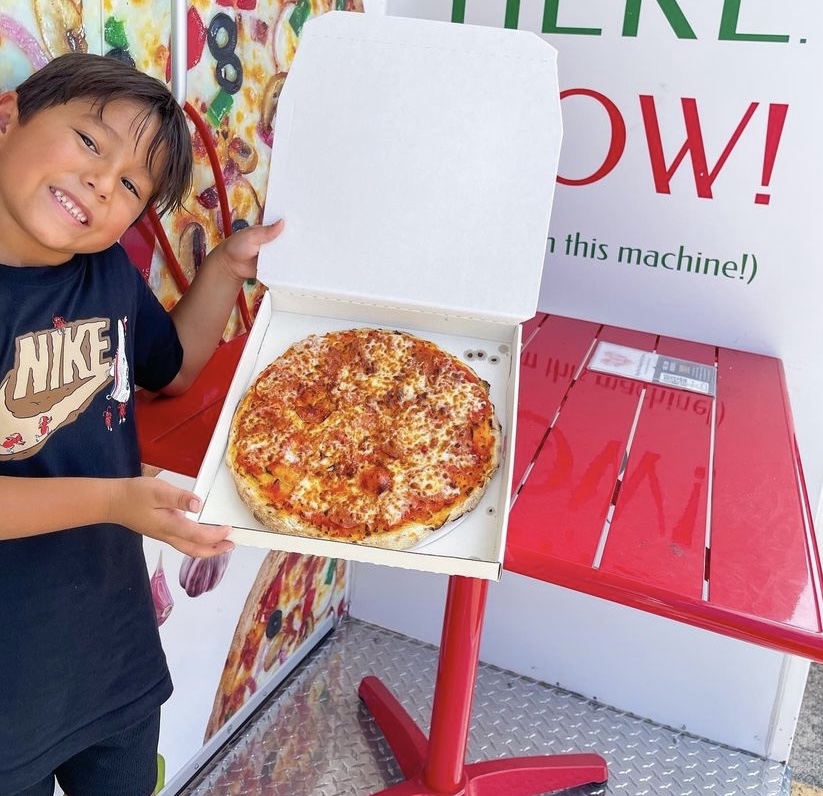- Les Tomlin, the cofounder of PizzaForno, sees a bright future for his company’s pizza vending machines, which are already popular abroad.
- In this Q&A, Tomlin offers suggestions for choosing the right location for a pizza machine and ponders the possibilities for creative topping options.
Pizza is the world’s most popular food—you might say it’s all that and a bag of chips. But whereas Doritos from a vending machine taste heavenly, can you get the same result with pizza? The brains behind PizzaForno think so.
Using robotic technology and a patented oven, PizzaForno offers all the convenience of a snack vending machine to serve up fresh, hot pies, which are premade and stored in the machine’s refrigerated section. Push a button, and your pie’s ready in under three minutes. PizzaForno’s machines have been offering 24/7 pizza service in Canada for several years now. In the United States, the first PizzaForno machine popped up in Jackson, Michigan, in early 2021. More recently, the machines were introduced at three locations in New Orleans.
Is the world ready for this type of innovation? For our section on pizza robotics in this year’s Pizza Power Report, Rick Hynum, PMQ’s editor in chief, reached out to PizzaForno cofounder Les Tomlin about the technology and how it’s spreading across North America. Here’s the full Q&A:
PMQ: We’re hearing more and more about pizza automation and kiosks in general, but we’re not seeing a lot of pizzeria owners or chains adopting this technology yet. But the interest is there. In your opinion, what factors will lead to widespread adoption of pizza-making kiosks, and how close or far away do you think we are?
Les Tomlin: There is a lot of buzz in the industry about robotics and technology, which both involve change. And to be quite honest, change is hard for some people. Some people still have a landline and/or a flip phone.
With most innovation, you have early adapters, like those that wait in line for the newest iPhone. Then there will be those that buy in later as they see the success. And you’ll always have the good ol’ mom-and-pop pizzeria and, I’m sure, those that think an automated pizzeria is sacrilegious. We are seeing versions of automation entering the larger chains, so the evolution has begun.
Some larger chains are already adopting partial time-saving automation with robotics that just stretch, sauce and cheese the pizza, saving valuable time in the kitchen. We will see this evolution with more pizza food trucks, mobile kitchens, kitchen automation, POS customer service interfaces, and the slow education of North America to the fact that you can actually get a pretty doggone good pizza from a machine.
The fact is, North America is the slowest to adopt this innovation. There are thousands of these pizza kiosks all over Europe and Asia. In France—where they say, “Food is holy,” and where the PizzaForno oven is manufactured—it took a couple years for it to become accepted, and now there are plans for 15,000-20,000 units in France alone. Don’t forget, France is about the size of Texas. So, buckle up, the automated “pizzaruption” is coming with our sites in 20,000 units by 2026.

PizzaForno’s kiosk debuted in July 2018. (PizzaForno / Facebook)
PMQ: Most of our readers are independent pizzeria operators. If they’re thinking about licensing this technology, what’s the smartest way to make it work for them? If you were a pizzeria operator with a PizzaForno machine, where would you put it and why?
Tomlin: Be first to the market, grow with a proven brand that will grow with you, and begin to think differently by using the technology to solve a problem. Don’t do it alone; lean on experience and evolve with the technology by discovering places where people want quality pizza but where no chain is ever going to build an expensive brick-and-mortar location.
Scout areas that don’t have access to good pizza, like food deserts or, better yet, pizza deserts, and discover areas where a 24/7-accessible automated pizzeria would serve a community well.
There are so many great places for a PizzaForno oven because there are three options, from the smallest unit (60 square feet) that is about the size of an ATM—perfect to add to an existing business—to an indoor kiosk (75 square feet), which is perfect for dining halls, cafeterias, hospitals and dorms—to the outdoor mobile unit (80 square feet) that is virtually indestructible and can be placed absolutely anywhere outdoors and be moved with the help of a flatbed truck.
The world of automated pizzerias opens the doors to locations never considered before by standard brick-and-mortar quick-service restaurants that are based on key metrics to drive high volumes. Obviously, high foot traffic is a metric we take into consideration, but it’s not the only factor. We’re looking at entertainment complexes, locations that are moving away from full-service kitchens, and those struggling with staffing as well as places that provide other services and where a simple food option compliments the service—like a bowling alley, trampoline park or auto repair shop. Most recently, we’re seeing interest from factories with a third shift that is limited in food options while expensive third-party delivery options are breaking the bank.
Finally, we are in negotiations with several large-scale hotel chains that have no food service offering. Having a 24/7 PizzaForno in the lobby satisfies a quick family need for a meal and generates additional revenue for the hotel that would otherwise have gone to a food delivery service. The options and potential are limitless.

PizzaForno / Facebook
PMQ: How simple do the pizzas need to be in terms of toppings for optimal performance of the machine? Any recommendations for developing a pizza that’s sure to perform well with the machine? For example, do you recommend a certain limit on the number of toppings? And are some toppings just not right for a machine-baked pizza?
Tomlin: It’s important for the customer to have options, and we try to keep it simple for the sake of inventory by offering seven or eight options at any given time. The advanced technology allows us to stock the unit based on the needs of the customer base, so we know which markets are veggie lovers compared to meat lovers and we can stock accordingly.
We believe keeping the pizza options simple is important, but we also know, based on the vast variety of pizza options in France, that the options are limitless. European automated pizzerias offer pizzas that include potatoes, smoked salmon, gyro meat and so many other combinations. We were blown away by the variety and different pallets per region.
So, the simple answer is, we will continue to learn based on the desires in each market and will continue to offer LTOs to test everything from dessert pizzas to region-specific options. Our Nutella “Chocolate Lovers” option over Valentine’s Day was a huge hit, and when a request for a pickle pizza came in from our Michigan market…wait, what? Yes, a pickle pizza. And it did well, so we introduced it across the system, and the overall response was great. Although it did not become one of the core seven, it will be in rotation, like other LTOs. We will also experiment with, like, a taco option and jalapenos requested in Houston.
All creative LTO options will go through the proper channels for testing, and I believe consumers will be pleasantly surprised with the creativity we will share in the years to come. Be on the lookout for a partnership coming soon (hint: our next LTO) that will add a topping to our pepperoni pizza that is a North American favorite in conjunction with one of the largest food providers in the world. Oh, I wish I could tell you what it is, but you’ll have to wait until the press release. It may make some uneasy, but wait until you try it. I’ll just say…game changer. The sky is the limit, and we will continue to press the limit with culinary creativity.













